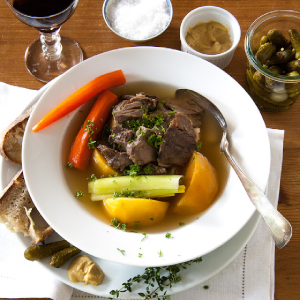I was recently reminded of an old tradition that’s pretty much lost today: Winter Soup. At least one of my grandmothers used the technique to save money, banish food waste, and feed a large family during hard times…
 The master pot: 45-year-old family perpetual soup pot at Watta Panich
The master pot: 45-year-old family perpetual soup pot at Watta Panich
– a third-generation traditional restaurant in Bangcock, Thailand.
Have you ever come across a reference, in any pre-World War II novel or cookbook, about the traditional winter soup pot? At least, that’s my Dad’s very British mom called it. I didn’t have to go too far to confirm that the thing existed – still exists – under the French traditional name Pot au Feu. It also goes by a string of other names in other places and cultures: Perpetual Stew, Forever Soup, Hunter’s Hot, Bottomless Broth, Master Stock, or Mother Broth.
You could also call it ‘Pot Roulette’
Wikipedia takes a very egalitarian stance on Pot au Feu:
“A perpetual stew […] is a pot into which whatever foodstuffs one can find is placed and cooked. The pot is never or rarely emptied all the way, and ingredients and liquid are replenished as necessary. Such foods can continue cooking for decades or longer, if properly maintained. The concept is often a common element in descriptions of as being flavorful due to the manner in which the ingredients blend together. Foods prepared in a perpetual stew have been described as being flavorful due to the manner in which the ingredients blend together.”
How perpetual is ‘perpetual soup’?
Wikipedia again provides some pretty spectacular examples:
- A batch of pot-au-feu was claimed by one writer to be maintained as a perpetual stew in Perpignan France, from the 15th century until World War II, when it ran out of ingredients to keep the stew going due to the German occupation.
- Wattana Panich restaurant in Bangkok, Thailand, has continued to maintain the broth from the same perpetual stew for over 48 years (as of 2023).
- The food industry in Japan still maintains perpetual stews in certain traditional dishes, for instance in ramen and oden: Otafuku, one of the oldest oden restaurants in Japan, has been heating up the same batch of broth every day since 1945.
- Between August 2014 and April 2015, a New York restaurant served broth from the same perpetual stew (a master stock) for over eight months.
‘If properly managed’ an important caveat
There is one cardinal rule when starting and maintaining a perpetual soup: Follow the time and temperature tenets of FAT TOM. Always re-heat perpetual soup or stew to the recommended temperature for preparing any leftover for serving.
The classic simmer is where you want to be. The whole mass of food in the pot should be maintained at or above 165 F during re-heating. But that’s easy. As we just said, keep the stuff simmering (small bubbles continually breaking on its surface) as if it was a stock pot doing its blessed and anointed job. A simmer tops out at between 180 F and 200 F (depending on atmospheric pressure where you live).
Don’t bring the mixture to a rolling boil every time you re-heat it – though my Grandma’s recipe called for that, probably as anecdotal proof that a safe germ-killing temperature had been reached.
If you overheat perpetual soup or simmer it too long at the top end of the temp range, even the stoutest root veggies or toughest meats will get mushy and your broth will become a cloudy opaque goop.
What Grandma always did…
Dad’s mom had a dedicated, covered pot for her ‘Winter Soup’. She called her’s that because she didn’t try to maintain it over the hotter months – just through the cold months when the prevailing temperatures out in the summer kitchen or back porch remained at or below about 40 F.
When she was doe with the pot for the day, she just moved it off the heat until it cooled enough to handle and detailed Grandpa (or her ablest son) to take pot out to the designated cold space until the time she wanted to use it or serve it. Your garage or root cellar will be a fine place to store your perpetual soup pot during its ‘time off’. If your pot is not too big. you can reserve a space for it on the lowest shelf in your ‘downstairs’ fridge, if you have one.
What to put in the pot – and what NOT
DO put any and all of the following in your perpetual Soup Pot:
- Leftover cooked, cured, smoked and raw meats, poultry or fish, or their bones
- Cooked or raw root veggies
- Onions, celery, ‘hard’ cabbage, and other robust ‘ground-level’ veggies such as corn kernels, or any dried legumes you like
- Whole grains or legumes such as peas, beans, quinoa, cracked barkey or other grains, green peas, corn kernels
- Use a gauze bag (‘chef’s teabag’) to contain herbs, spices (whole), and anything you want to infuse into your stew but will want to skim or filter out before serving.
- Also use a gauze bag to contain stuff like shellfish shells, fish bones or other animal parts you want to ‘mine’ for flavours, then discard.
- Any pre-existing broths or aromomatic liquids (beer, wine, spirits)
- Prepared foods such as pickles, or fermented foods like sauerkraut.
It’s your flavour adventure. You decide where you want it to go…
DO NOT use any of the following to prevent unwanted clouding or unwanted thickening of your perpetual soup:
- Leafy greens
- Squashes (summer or winter; both will mush-out quickly!)
- Pasty starches (mashed potatoes – or anything puréed, for that matter)
- Thickened gravies or sauces
After a while, you’ll be able to just glance at any candidate for the perpetual soup pot and decide instantly whether it’s appropriate or not.
I’m gong to start a small-scale experiment in perpetual soup and run it through coming spring. Say, until the 24th of May (the unofficial start of Summer where I live). If it works out well, I’ll keep it going… perpetual Last words
What a great way to cut food waste, cram meals with fantastic flavours and save a (potential) bagful; o cash at th uoermarket!
~ Maggie J!

